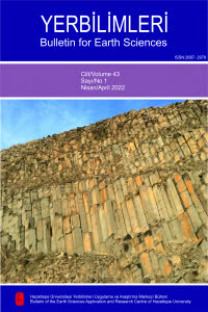Tahribatsız yöntemlerle tarihsel yapılarda ayrışmanın belirlenmesi: Türkmenistan'ın Merv şehrine ait uygulama
Non-destructive methods for determining weathering in historical monuments: a case study from Merv city, Turkmenistan
___
- Aköz, F., 2005. Yığma yapılarda hasar tespiti deney ve ölçüm yöntemleri. YDGA2005 Yığma Yapılarda Deprem Güvenliğinin Arttırılması Çalıştayı (in Turkish).
- Bruneau, C., Forrer, A., Cuche, A., 1995. Une méthode d’investigation non destructive des matérieaux pierreux: les mesures à l’ultrason. Proceedings of the Congr, LCP ’95, Preserv. and Restor. of Cultur. Heritage, Montreux, 187-195.
- Demirboğa, R., Türkmen, I., Karakoç, M. B., 2004. Relationship between Ultrasonic Velocity and Compressive Strength for High-Volume Mineral-Admixtured Concrete. Cement and Concrete Research 34: 2329-36.
- Gladwin, M.T., 1982. Ultrasonic stress monitoring in underground mining. Int. J. Rock Mech. Miner. Sci. 19, 221 – 228.
- Herrmann, G., 1999. Monuments of Merv. Traditional Buildings of the Karakum. London: Society of Antiquaries London.
- Herrmann, G. Coffey H., Laidlaw S., Kurbansakhatov. K., 2002. The Monuments of Merv - A scanned archive of photographs and plans. London: University College London and British Institute of Persian Studies.
- Hornibrook, F.B., 1939. Application of sonic method to freezing and thawing studies of concrete, ASTM Bull., 101, 5.
- Hudson, T.A., Jones, E.T.W., 1980. New, B.M., P-wave velocity measurements in a machine bored chalk tunnels. Q. J. Eng. Geol. 13, 33 – 43.
- Jones, R. 1948. The Application of Ultrasonic to the Testing of Concrete, Research, London, 383.
- IAEA (International Atom Energy Agency), 2002. Guidebook on non-destructive testing of concrete structures. International Atomic Energy Agency, Vienna.
- Khan, S. R. M., Noorzaei, J., Kadir, M. R. A., Waleed, A. M. T., Jaafar, M. S., 2007. UPV Method for Strength Detection of High Performance Concrete. Structural Survey 25 (1): 61-73.
- Leslie, J.R., Cheesman, W.J., 1949. An ultrasonic method of studying deterioration and cracking in concrete structures, ACI J. Proc., 46(1), 17.
- Lin, Y., Lai, C. P., Yen, T., 2003. Prediction of Ultrasonic Pulse Velocity (UPV) in Concrete. ACI Materials Journal 100 (1): 21-8.
- Malhotra, V.M,. 1976. Testing Hardened Concrete: Nondestructive Methods, ACI Monograph 9, American Concrete Institute, Detroit, MI.
- Malhotra, VM., Carino, NJ., 2004. Handbook On Non-destructive Testing of Concrete, CRC Press.
- Meneghetti, L. C., Padaratz, I. J., Steil, R. O., 1999. 'Use of Ultrasound to Evaluate Concrete Strength in the Early Ages'. Proceedings of International Symposium on Nondestructive Testing Contribution to the Infrastructure Safety Systems in the 21st Century, pp 42-47.
- Mix, P.E., 2005. Introduction to Non-destructive Testing, a Training Guide, Published by John Wiley & Sons, Inc., Hoboken, New Jersey.
- Neville, A. M., Brooks, J. J., 1997. Concrete Technology. 6. ed. Singapore: Longman Singapor Publishers Pte.
- Obert, L., 1939. Sonic method of determining the modulus of elasticity of building materials under pressure. Proc. ASTM, 39, 987.
- Onodera, T.F., 1963. Dynamic investigation of foundation rocks, in situ. Proc. 5th Symp. Rock Mech., Minnesota. Pergamon, New York, pp. 517 – 533.
- Popovics, S., 1998. Strength and Related Properties of Concrete: A Quantitative Approach. New York. 535 p., John Wiley and Sons.
- Powers, T.C., 1938. Measuring Young’s modulus of elasticity by means of sonic vibrations, Proc. ASTM, 38 (Part II), 460.
- Proceq, 2017. Operating Instructions Pundit Lab/Pundit Lab+ Ultrasonic Instrument, Pundit Lab complies with the following standards: EN 12504-4 (Europe), ASTM C597-02 (North America), BS 1881 Part 203 (UK), ISO1920-7:2004 (International), IS13311 (India), CECS21 (China).
- Pucinotti, R., 2005. Pathology and diagnostics of reinforced concrete, Dario Flaccovio Editore, Palermo, Italia.
- Sheen, N. Y., Huang, J. L., Le, D. H., 2013. Predicting Strength Development of RMSM Using Ultrasonic Pulse Velocity and Artificial Neural Network. Computers and Concrete 12 (6): 785-802.
- Smith R.T., Stephens, R.W.B., 1964. Effects of Anisotropy on Ultrasonic Propagation in Solids, Progress in Applied Materials Research, E.G. Stanford, J.H. Fearon, and W.J. McGonnagle, Ed., Vol 5, Gordon and Breach, London, p 39-64.
- Thomson, W.T., 1940. Measuring changes in physical properties of concrete by the dynamic method, Proc. ASTM, 40, 1113.
- Tarun R. Naik, T.R., Malhotra, V.M., Popovics, J.S., 2004. The Ultrasonic Pulse Velocity Method, In: V.M. MALHOTRA and N.J. CARINO, Edited 2004, Handbook On Nondestructive Testing of Concrete, CRC Press.
- Yusuf, I. T., Jimoh, Y. A., 2014. Correlation of Pundit Ultrasonic Pulse Velocity with Strength of Palm Kernel Shell Concrete. Annals of Faculty Engineering Hunedoara-International Journal of Engineering 2: 51-7.
- ISSN: 1301-2894
- Yayın Aralığı: 3
- Başlangıç: 1976
- Yayıncı: Hacettepe Üniversitesi Yerbilimleri Uygulama ve Araştırma Merkezi
Yansıma Seyahat Zamanı Tomografisi: İzmir Körfezi için Örnek Bir 2B Çalışma
Zehra ALTAN, Gualtiero BÖHM, Neslihan OCAKOĞLU
İstanbul Avcılar Heyelanı Üzerinde VLF ve ERT Yer İletkenlik Modellerinin Kıyaslanması
Gökhan KARCIOĞLU, Rafet Ender ALEMDAR, Leyla EVGİ
Bakırtepe (Sivas-Kangal) altın cevherleşmelerinin oluşum ve zenginleşme evrelerinin kavramsal modeli
Özcan DUMANLILAR, İsmail CİHAN, Mehmet EKMEKÇİ, Gökhan KANAAT, Can AYDOĞAN, Oğuz TURUNÇ
